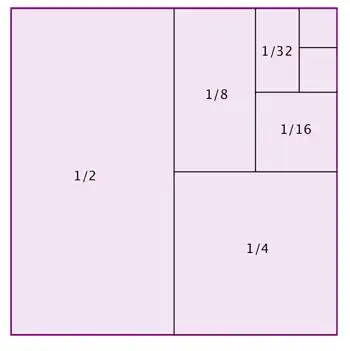Others have tried to answer your direct question, but based on your interactions here, I believe your confusion is actually about what a limit is and how it works, so I will try to answer that instead.
A limit of a sequence of numbers $s = (s_0, s_1, s_2, ...)$, if it exists, is a number such that eventually (starting from far enough in the sequence), all elements of the sequence are arbitrarily close to $\mathsf{limit}(s)$.
To make the above a bit more mathematically precise: a number $n_{lim}$ is a limit of a sequence $s$ if and only if for an arbitrary error bound $\epsilon$, all numbers of the sequence but those from some finite inital portion of it are within the interval
$$(n_{lim} - \epsilon, n_{lim} + \epsilon)\,.$$
Notice that the limit itself needs not ever be present in the sequence itself! It is sufficient that the sequence gets "closer and closer". For example, the limit of $(0, 0.3, 0.33, 0.333, ...)$ is $1/3$, despite that $1/3$ is not an element of the sequence.
Also notice that taking the limit is not a process that computes someting / eventually spits out some number. (Even though you can intuitively think of it in such way, if you prefer.) A limit is simply a number which satisfies the above formal definition.0
Now back to
$$\sum_{n=1}^{\infty}\left(\frac{1}{2}\right)^n = 1\,.$$
In math,
$$\sum_{n=1}^{\infty}\dots$$
is defined as
$$\mathsf{limit}(\sum_{n=1}^0\dots,\sum_{n=1}^1\dots,\sum_{n=1}^2\dots, \dots)\,.$$
That is, we're defining how to perform an infinite summation by trying to find out which number we're approaching as we sum more and more terms. Again, the result needs not appear at any finite "stage" of the "process", it just needs to get "closer and closer".
So we have
$$\begin{align*}
\sum_{n=1}^{\infty}\left(\frac{1}{2}\right)^n &= \mathsf{limit}(
\sum_{n=1}^0 0.5^n,
\sum_{n=1}^1 0.5^n,
\sum_{n=1}^2 0.5^n,
\dots)\\
&= \mathsf{limit}(0, 0, 0.5, 0.75, 0.875, ...)\,.
\end{align*}$$
Now take any arbitrary bound, let's say $0.3$. All numbers of this sequence except the initial three are within $(1-0.3, 1+0.3)$. Let's take a tighter bound, $0.2$. All but the initial four are within $(1-0.2, 1+0.2)$. In fact, we can prove that for any positive $\epsilon$, only the initial <I-don't-know-how-many> elements are going to be outside $(1-\epsilon, 1+\epsilon)$, all the rest are within. That's why
$$1 = \mathsf{limit}(0, 0, 0.5, 0.75, 0.875, ...)$$
Footnotes:
- It is provable that any two numbers that are a limit of the same sequence equal each other. Therefore, any sequence has at most one limit (but may have none if it diverges).
